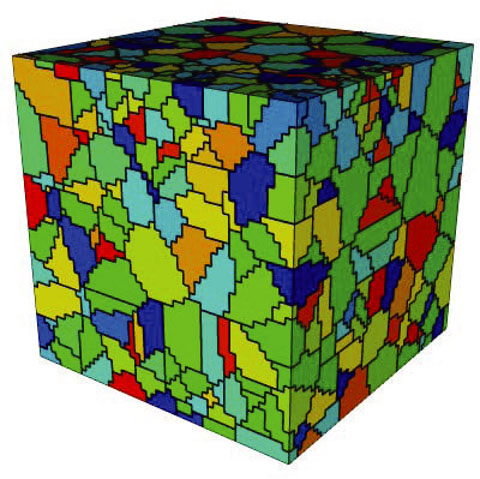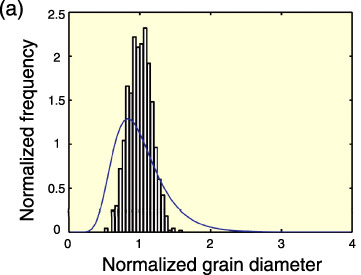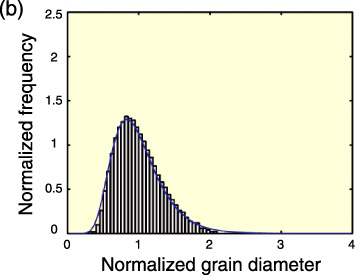
Fig.12-6 Polycrystal produced by a genetic algorithm


Fig.12-7 Grain size distribution before optimization (a) and after optimization (b)
Most solid materials, including those applied to nuclear devices, are composed of many grains as seen in Fig.12-6. It is of great importance to understand the degradation mechanism of such a polycrystal, and a possible mechanism could be the reduction of atomistic bonding force at grain boundaries. To predict degradation, it is therefore necessary to reproduce grain configurations as observed in experiments and to evaluate the strength of materials based on such grain configurations. For this purpose, we attempted to develop a software program to automatically produce a polycrystal with a realistic grain configuration, which is critical to improving the prediction of nuclear materials degradation.
In the course of the software development, however, we realized that the calculation time became enormous if the conventional method was applied, and it was impossible to obtain a realistic grain configuration. Fortunately we noticed that application of a genetic algorithm (GA) could overcome this difficulty. GAs provide a numerical optimization method originating in the Darwinian theory of evolution. According to this theory, many individuals of the same species gradually adapt to their environment; GAs utilize such a process for solving numerical optimization problems.
In this particular application, we prepared in advance many unrealistic polycrystals instead of many individuals of the same species. We let some relatively favored polycrystals survive and abandoned the rest as in the theory of natural selection. The surviving polycrystals became the parents of polycrystals in the subsequent generation that were slightly different from their parents; this corresponds to multiplication in the theory of evolution. Among the individuals of the next generation, we again let some relatively favored polycrystals survive. Through iteration of this procedure, we repeatedly selected some of the best polycrystals from many samples at the same time. Thus optimization was accelerated and it was possible to obtain a polycrystal that satisfied the desired grain size distribution (Fig.12-7).
The method described above for the first time made it possible to construct realistic polycrystals composed of a few thousand grains, and to supply initial conditions for material simulations of grain growth, deformation, and fracture, all of which are critical to the development of nuclear materials.